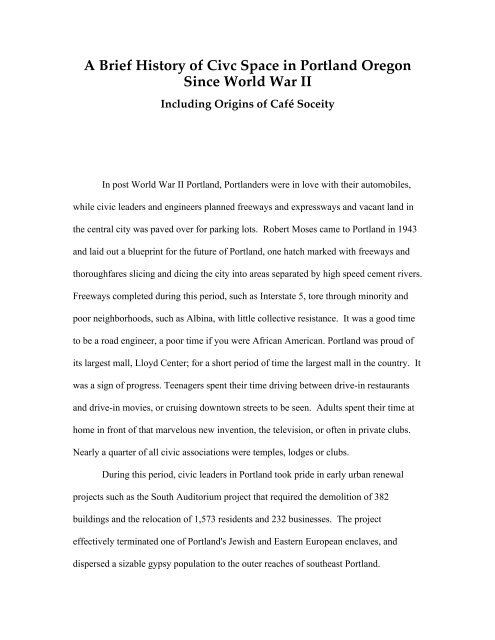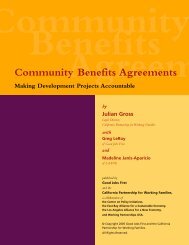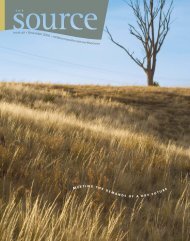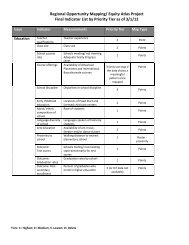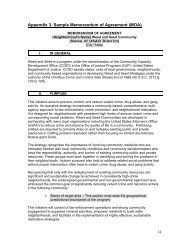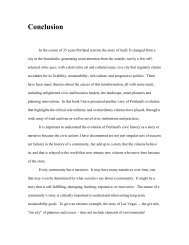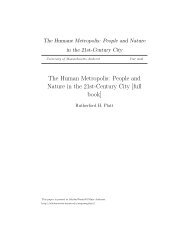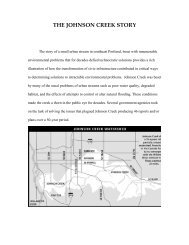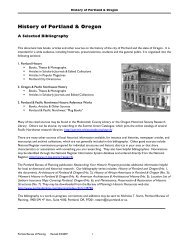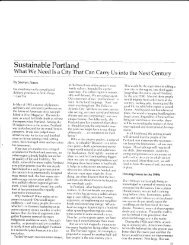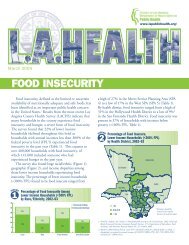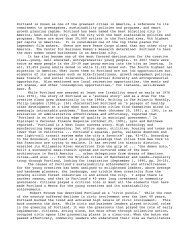A Brief History of Civc Space in Portland Oregon Since World War II
A Brief History of Civc Space in Portland Oregon Since World War II
A Brief History of Civc Space in Portland Oregon Since World War II
You also want an ePaper? Increase the reach of your titles
YUMPU automatically turns print PDFs into web optimized ePapers that Google loves.
A <strong>Brief</strong> <strong>History</strong> <strong>of</strong> <strong>Civc</strong> <strong>Space</strong> <strong>in</strong> <strong>Portland</strong> <strong>Oregon</strong>S<strong>in</strong>ce <strong>World</strong> <strong>War</strong> <strong>II</strong>Includ<strong>in</strong>g Orig<strong>in</strong>s <strong>of</strong> Café SoceityIn post <strong>World</strong> <strong>War</strong> <strong>II</strong> <strong>Portland</strong>, <strong>Portland</strong>ers were <strong>in</strong> love with their automobiles,while civic leaders and eng<strong>in</strong>eers planned freeways and expressways and vacant land <strong>in</strong>the central city was paved over for park<strong>in</strong>g lots. Robert Moses came to <strong>Portland</strong> <strong>in</strong> 1943and laid out a bluepr<strong>in</strong>t for the future <strong>of</strong> <strong>Portland</strong>, one hatch marked with freeways andthoroughfares slic<strong>in</strong>g and dic<strong>in</strong>g the city <strong>in</strong>to areas separated by high speed cement rivers.Freeways completed dur<strong>in</strong>g this period, such as Interstate 5, tore through m<strong>in</strong>ority andpoor neighborhoods, such as Alb<strong>in</strong>a, with little collective resistance. It was a good timeto be a road eng<strong>in</strong>eer, a poor time if you were African American. <strong>Portland</strong> was proud <strong>of</strong>its largest mall, Lloyd Center; for a short period <strong>of</strong> time the largest mall <strong>in</strong> the country. Itwas a sign <strong>of</strong> progress. Teenagers spent their time driv<strong>in</strong>g between drive-<strong>in</strong> restaurantsand drive-<strong>in</strong> movies, or cruis<strong>in</strong>g downtown streets to be seen. Adults spent their time athome <strong>in</strong> front <strong>of</strong> that marvelous new <strong>in</strong>vention, the television, or <strong>of</strong>ten <strong>in</strong> private clubs.Nearly a quarter <strong>of</strong> all civic associations were temples, lodges or clubs.Dur<strong>in</strong>g this period, civic leaders <strong>in</strong> <strong>Portland</strong> took pride <strong>in</strong> early urban renewalprojects such as the South Auditorium project that required the demolition <strong>of</strong> 382build<strong>in</strong>gs and the relocation <strong>of</strong> 1,573 residents and 232 bus<strong>in</strong>esses. The projecteffectively term<strong>in</strong>ated one <strong>of</strong> <strong>Portland</strong>'s Jewish and Eastern European enclaves, anddispersed a sizable gypsy population to the outer reaches <strong>of</strong> southeast <strong>Portland</strong>.
Most <strong>of</strong> the “third places” were run-<strong>of</strong>-the mill taverns and bars. The colleges <strong>in</strong>town did not spawn districts with student and faculty hang outs. Before the wave <strong>of</strong>c<strong>of</strong>fee houses and music clubs <strong>in</strong> the late 1960s, the young people and students <strong>in</strong><strong>Portland</strong> had only a few unique choices, such as Café Expresso, owned by Walter Cole,later a locally famous cross dress<strong>in</strong>g enterta<strong>in</strong>er. At Paul Hebb’s 13th Ave Gallery <strong>in</strong>Sellwood (near Reed College), there were jazz and jug band performances, poetryread<strong>in</strong>gs, and “open mike diatribes.” The Folks<strong>in</strong>ger provided espresso dr<strong>in</strong>ks and theopportunity to listen to the live music <strong>of</strong> Lighten<strong>in</strong>g Hopk<strong>in</strong>s, John Lee Hooker, and localbanks such as the P.H. Phactor Jug Band. The c<strong>of</strong>fee shop was almost unheard <strong>of</strong>. ThePolk City Directory listed four <strong>in</strong> 1956.There were 24 private clubs <strong>in</strong> 1955 with 16,000 members, most <strong>of</strong> them werespecialized or exclusive. The Arl<strong>in</strong>gton club, one <strong>of</strong> the most exclusive, was described asa “pillar <strong>of</strong> dignity with its members enjoy<strong>in</strong>g club life without female <strong>in</strong>terference.Activities are chiefly card and other games, traditional men’s club chatter <strong>in</strong> lounges,man-style meals <strong>in</strong> the club d<strong>in</strong><strong>in</strong>g room and library brows<strong>in</strong>g.”In the late 1960s and early 1970s, City <strong>of</strong> <strong>Portland</strong> leaders tried to control publicspace as a way <strong>of</strong> hon<strong>in</strong>g <strong>in</strong> on young civic activists and "hippies." While the civicleaders could do little to prohibit youth from travel between cities or frequent<strong>in</strong>galternative bus<strong>in</strong>esses or spend<strong>in</strong>g time on college campuses, city <strong>of</strong>ficials and policecould home <strong>in</strong> on parks and open spaces that became known as places for counter-cultureresidents and travelers to congregate. In the late 1960s the parks, once seen as places tochannel youthful energy away from del<strong>in</strong>quent behavior, became disputed civic placeswhere the clash between generations was most visible.
In August 1968 the <strong>Portland</strong> City Council passed an ord<strong>in</strong>ance (#127194) mak<strong>in</strong>git illegal to be <strong>in</strong> any city park between the hours <strong>of</strong> 11 p.m. and 5 a.m. While the neword<strong>in</strong>ance applied to all parks, it was evident the law was aimed at one park <strong>in</strong> particular,Lair Hill Park, which had become a magnet for hippie youth. The adjo<strong>in</strong><strong>in</strong>gneighborhood afforded cheap hous<strong>in</strong>g, a “psychedelic” supermarket, a natural foodsstore, a location midway between Lewis and Clark College and <strong>Portland</strong> State College, aswell as the first community switchboard (Contact Center, which later moved todowntown). It had all the elements needed to create a hippie ghetto.In the summer <strong>of</strong> 1968 there was also fear <strong>in</strong> the air <strong>in</strong> several west coast cities <strong>of</strong>massive hippie <strong>in</strong>vasions. The hippies were seen as on the move like herds <strong>of</strong> elk ormigrat<strong>in</strong>g birds. One person testify<strong>in</strong>g <strong>in</strong> support <strong>of</strong> the new park curfew also circulateda petition “to halt the <strong>in</strong>flux <strong>of</strong> hippies <strong>in</strong>to our city.”There were protests aga<strong>in</strong>st the ord<strong>in</strong>ance <strong>in</strong> Lair Hill park. A spontaneous act <strong>of</strong>civil disobedience took place the night after the ord<strong>in</strong>ance’s passage. Denise (Brooke)*Jacobsen, a local resident, and later a founder <strong>of</strong> the Northwest Film Study Center (now apr<strong>of</strong>essor at <strong>Portland</strong> State University) walked <strong>in</strong>to the park after 11 p.m. and swung on asw<strong>in</strong>g, with a companion, and were arrested. Some <strong>of</strong> the activists found ways aroundthe curfew. One could be issued a permit to use the park after hours. One such permitissued to David Ewen, repr<strong>in</strong>ted <strong>in</strong> an underground press, described his permitted use as“for the purpose <strong>of</strong> sw<strong>in</strong>g<strong>in</strong>g, teeter-totter<strong>in</strong>g, us<strong>in</strong>g the merry-go-round and slide,walk<strong>in</strong>g, sitt<strong>in</strong>g, and stand<strong>in</strong>g and runn<strong>in</strong>g. (As I was stroll<strong>in</strong>g, 1968, p. 8).”The clash over use <strong>of</strong> public parks reveals one aspect <strong>of</strong> the civic transformationdur<strong>in</strong>g the civic reconstruction period. It can also be seen through the emergence <strong>of</strong> new
* added Learn<strong>in</strong>g Community and Terrasquirma here. Although now as part <strong>of</strong> civicspace some <strong>of</strong> the details may not fit, or some might be transferrred elsewhere>Some experiments <strong>in</strong> collective action flared <strong>in</strong>to be<strong>in</strong>g and then disappearedbut not without leav<strong>in</strong>g traces beh<strong>in</strong>d. Typical <strong>of</strong> those experiments were theLearn<strong>in</strong>g Community and Terrisquirma.The Learn<strong>in</strong>g Community, an experimental <strong>in</strong>stitution <strong>of</strong> higher education formedat Reed College <strong>in</strong> 1970 typifies the successes and failures <strong>of</strong> ventures that tried tochange it all—<strong>in</strong>dividuals, communities, the planet. Reed College has long beenconsidered <strong>Portland</strong>’s most unique college. A world unto itself. Long before <strong>Portland</strong>ersknew about hippies or Beatniks, they labeled “different” people as “Reedies.” In the late1960s at Reed College (as elsewhere <strong>in</strong> the country) younger faculty and studentsattempted to make changes <strong>in</strong> a curriculum they considered antiquated. A primaryobjective was to give more voice to students and more power to younger faculty <strong>in</strong> asystem controlled by seniority. A critical issue raised by students and younger facultywas the need to <strong>in</strong>corporate Black studies <strong>in</strong> the curriculum and, <strong>in</strong> effect, to change thebasic humanities canon <strong>of</strong> the college. In the summer <strong>of</strong> 1966, Howard Waskow andRandal Snodgrass, both part <strong>of</strong> the younger faculty crowd, started a program they calledUpward Bound--a program aimed at giv<strong>in</strong>g disadvantaged m<strong>in</strong>ority high school studentsa head start <strong>in</strong> the transition to college. This program did not sit well with some facultyand became the wedge that separated Waskow and others from the senior faculty andadm<strong>in</strong>istrators. In the second summer <strong>of</strong> the program, some faculty felt “mortified by thebehavior <strong>of</strong> these unruly kids on their campus (White, 1995, p. 49).” As a result, Waskow
and Snodgrass were relieved <strong>of</strong> their duties.In the summer <strong>of</strong> 1967 Waskow, Snodgrass, and several others met at a ranch <strong>in</strong>Montana belong<strong>in</strong>g to Jon and Deayne Roush. Jon was a key figure <strong>in</strong> the formation <strong>of</strong>the Learn<strong>in</strong>g Community because he was on leave from Reed College, and work<strong>in</strong>g forthe Carnegie Corporation, a philanthropic foundation that funded and supported<strong>in</strong>novative experimental education projects around the country. This first meet<strong>in</strong>g at theRousch ranch was followed by subsequent meet<strong>in</strong>gs <strong>in</strong> <strong>Portland</strong>, as the loose group beganto def<strong>in</strong>e an educational <strong>in</strong>stitution that would meet needs unmet at Reed. In an <strong>in</strong>terview<strong>in</strong> the 1990s John Laursen, another Learn<strong>in</strong>g Community member, compared this stage <strong>in</strong>the learn<strong>in</strong>g community’s development to the 1992 presidential candidacy <strong>of</strong> Ross Perot:a blank slate onto which everyone could project his or her own vision <strong>of</strong> the future(White, 1995, p. 57).” The group considered many elements for their learn<strong>in</strong>gcommunity, <strong>in</strong>clud<strong>in</strong>g: a people’s plant nursery, an ecology bookstore, an organic gardenat Reed, opportunity to be tra<strong>in</strong>ed as air pollution <strong>in</strong>dex readers, and formation <strong>of</strong><strong>in</strong>formal groups to discuss social sciences and humanistic psychology, and politics andeconomics <strong>of</strong> ecology.In 1970 the group submitted a proposal to the Carnegie Corporation. Thecommunity at the time consisted <strong>of</strong> about 30 members with plans to expand to 200 to 300members on two sites, one urban and one exurban. The group experimented with newforms <strong>of</strong> democratic decision mak<strong>in</strong>g. Roush (White, 1995, p. 75) wrote that “thecommunity will be governed <strong>in</strong> all important aspects by the community as a whole.Every member <strong>of</strong> the community will have a voice, for example, <strong>in</strong> decisions aboutadmitt<strong>in</strong>g new members, about “curriculum” and about the budget (White, 1995, p. 75).”
August, Riverfront for People announced their plans to hold a picnic <strong>in</strong> the desolate scene<strong>of</strong> Harbor Drive. Doug Baker, an <strong>Oregon</strong> Journal columnist, announced the event(Bonner, 2000) as a festive occasion to celebrate an alternative to the “<strong>Oregon</strong> StateHighway Commission’s concrete mystic mazes.”On August 20 th , 250 adults and 100 children showed up for the picnic on thewaterfront, and at least partly as a result <strong>of</strong> outpour<strong>in</strong>g <strong>of</strong> citizens, Governor Tom McCall<strong>in</strong>structed his n<strong>in</strong>e-member Intergovernmental Task Force to prepare for a public hear<strong>in</strong>g,possibly as soon as mid September, on three options for Harbor Drive: a cut and coverplan which would bury Harbor Drive; a plan for the relocation <strong>of</strong> a six-lane Harbor Drivealong Front Avenue; and a plan simply to straighten and widen Harbor Drive after thedemolition <strong>of</strong> the <strong>Oregon</strong> Journal build<strong>in</strong>g. At the time State Highway Eng<strong>in</strong>eer ForrestCooper stated that the Task Force had ruled out any possibility <strong>of</strong> clos<strong>in</strong>g Harbor Drive,as projections show 90,000 trips per day <strong>in</strong> the corridor by 1990. He also said taskforcemembers favored the “cut and cover” plan (Bonner, 2000).In the meanwhile Riverfront for People organized another block party andannounced plans to circulate a petition for a downtown riverfront park. In response to theris<strong>in</strong>g voice <strong>of</strong> citizens, the Governor’s taskforce conducted an all-day Public hear<strong>in</strong>g todiscuss options for Harbor Drive. The architect members Riverfront for People presenteddraw<strong>in</strong>gs <strong>of</strong> a riverfront park, along with a petition with 2500 signatures urg<strong>in</strong>g theGovernor’s Taskforce to stop plans for road expansion and consider a park.At his po<strong>in</strong>t McCall abandoned his <strong>in</strong>ter-governmental taskforce and requested $7million <strong>in</strong> federal highway funds for the development <strong>of</strong> the riverfront and urged thecreation <strong>of</strong> a citizens’ advisory committee to help plan the project. In January 1971, the
State Highway Commission held a hear<strong>in</strong>g on the closure <strong>of</strong> Harbor Drive and <strong>in</strong>November <strong>of</strong> the same year the <strong>Portland</strong> City Council passed an ord<strong>in</strong>ance to close theroad.Virtual Civic <strong>Space</strong>One <strong>of</strong> the strik<strong>in</strong>g elements <strong>of</strong> the civic reconstruction period was the attempt byactivists, dispersed by graduation from college and pushed on by economic necessity, torecreate communities and cont<strong>in</strong>ue the social energy <strong>of</strong> idealism through gather<strong>in</strong>gs.Dur<strong>in</strong>g the early 1970s there were particular gather<strong>in</strong>gs and conferences that became thespr<strong>in</strong>gboard for the organizational stage <strong>of</strong> social movements. In 1974, for example, over800 activists from cities, towns and rural areas around the Pacific Northwest met <strong>in</strong>Ellensburg, Wash<strong>in</strong>gton, at the Alternative Agriculture Conference, an event that is <strong>of</strong>tenregarded as a pivotal event <strong>in</strong> the evolution <strong>of</strong> the Northwest’s extensive organic farm<strong>in</strong>gand natural foods movement. Other more amorphous conferences brought togetheractivists across a variety <strong>of</strong> issue <strong>in</strong>terest areas such as the Global Village Conferenceheld <strong>in</strong> 1973 at Evergreen State College <strong>in</strong> Olympia, Wash<strong>in</strong>gton, and <strong>in</strong> 1976 the LeapYear Conference <strong>in</strong> <strong>Portland</strong>, Tools for Transition conference <strong>in</strong> Seattle, and theCommunity Strengths Conference <strong>in</strong> <strong>Portland</strong>, also <strong>in</strong> 1976.One <strong>of</strong> the more extraord<strong>in</strong>ary events dur<strong>in</strong>g this period was organized by authorKen Kesey. The Bend <strong>in</strong> the River (BITR) conference was funded through the <strong>Oregon</strong>
Humanities Council. The <strong>in</strong>tent <strong>of</strong> the gather<strong>in</strong>g was to br<strong>in</strong>g together <strong>Oregon</strong>ians toenvision what <strong>Oregon</strong> could or should be like <strong>in</strong> 2010. Lead<strong>in</strong>g up the this statewideconference <strong>in</strong> Bend, <strong>Oregon</strong>, <strong>in</strong> 1975, Kesey, along with Kesey’s followers, the MerryPranksters, and young activists, held meet<strong>in</strong>gs <strong>in</strong> over 20 communities around the state toelect delegates and develop a slate <strong>of</strong> local concerns to take to the conference. By somemeasures the conference failed, for the slate <strong>of</strong> suggested civic <strong>in</strong>novations developed atthe state-wide conference were not acted upon. But the conference served the need tobr<strong>in</strong>g together new social activists. In a reflection about BITR soon after Kesey died <strong>in</strong>2002, one <strong>of</strong> the local organizers (Darl<strong>in</strong>g, 2001) summarized Kesey’s <strong>in</strong>tention as moreart than politics. “Bend <strong>in</strong> the River,” he said was like “the Twilight Bark <strong>in</strong> ‘101Dalmatians.’ It's how you f<strong>in</strong>d out that everyone's still out there and what they're th<strong>in</strong>k<strong>in</strong>gtonight. And that you're not alone. Kesey [called] it "the stammer <strong>of</strong> truth" that comeswhen folks are just say<strong>in</strong>g it pla<strong>in</strong>, not through speechwriters and press releases andtelevision. He [called] it the politics <strong>of</strong> affection. (p. 3)The f<strong>in</strong>al event <strong>in</strong> Bend attracted over 500 activists from around the state andmade a memorable connection between the wild 1960s and the organizational-bent1970s. It was where Senator Wayne Morse gave his last public speech, and whereKesey’s band <strong>of</strong> followers, and admirers--such as Roll<strong>in</strong>g Stone photographer AnnieLiebonitz, natural health advocate Andrew Wild, and alternative press guru, PaulKrasner, m<strong>in</strong>gled with some <strong>of</strong> <strong>Oregon</strong>’s future political leaders such as <strong>Oregon</strong>’s currentSecretary <strong>of</strong> State Bill Bradbury.Innovative forums like Bend <strong>in</strong> the River were <strong>in</strong>stigated to facilitate socialnetwork<strong>in</strong>g. It was not always easy to f<strong>in</strong>d like m<strong>in</strong>ds and “comrades” with similar
<strong>in</strong>terests. One <strong>of</strong> the tools <strong>of</strong> the organizer’s trade dur<strong>in</strong>g this period were the <strong>in</strong>stantdirectories for participants at gather<strong>in</strong>gs. In the years before computers, email, and theInternet, it was more difficult to meet people, keep them organized <strong>in</strong>to collectiveorganizations and cont<strong>in</strong>ue to share <strong>in</strong>formation and visions. Instant directories,sometimes referred to as people-to-people <strong>in</strong>dices, were pr<strong>in</strong>ted and distributed at theconferences or soon after. A typical entry <strong>in</strong>cluded name, address and telephone number,and a description <strong>of</strong> the person’s projects, resources, and <strong>in</strong>terests. Typical entries from apeople-to-people <strong>in</strong>dex at a gather<strong>in</strong>g <strong>in</strong> <strong>Portland</strong> <strong>in</strong> 1974 <strong>in</strong>cluded: Lloyd Marbet,<strong>in</strong>terest: stopp<strong>in</strong>g nuclear power, Carol Smith, <strong>in</strong>terests: video projects and calligraphy,Joseph Miller, <strong>in</strong>terests: stopp<strong>in</strong>g logg<strong>in</strong>g <strong>in</strong> sensitive areas, <strong>in</strong>clud<strong>in</strong>g <strong>Portland</strong>’s watersupply.While some conferences and gather<strong>in</strong>gs were eclectic, designed to “network”activists across <strong>in</strong>terest and issue boundaries, others were designed to br<strong>in</strong>g forth specificnew issues and activists, such as the <strong>Oregon</strong> Energy Fair (<strong>Portland</strong> 1977), the Women <strong>in</strong>Solar Energy and Appropriate Technology conference (Seattle 1978), and the Womenand Energy Conference (<strong>Portland</strong> 1980).
it was deeply rooted <strong>in</strong> citizens’ advisory committees. Through this mechanism, citizenswere consulted extensively on all projects, <strong>in</strong>clud<strong>in</strong>g the development <strong>of</strong> McCallWaterfront Park, the revival and design <strong>of</strong> the downtown core, and the development <strong>of</strong>the light rail system. A bus mall (<strong>Portland</strong> Mall) was created downtown to speed upservices and act as a transfer po<strong>in</strong>t to other l<strong>in</strong>es. It also tied downtown with other regionstogether along a north-south axis. Any citizen was free to jo<strong>in</strong> any <strong>of</strong> the subcommitteeson topics such as park<strong>in</strong>g, waterfront development, hous<strong>in</strong>g and retail<strong>in</strong>g. TheDowntown Plan was updated <strong>in</strong> 1980 to address changes related to scale and design <strong>of</strong>development. It had 3 key elements key to the nurtur<strong>in</strong>g <strong>of</strong> civic space: pedestrianamenities, a mix <strong>of</strong> densities and activities and land uses, especially retail and hous<strong>in</strong>gwith greater reliance on public transportation.In 2008 when <strong>Portland</strong> embarked on its comprehensive plan process the twoelements that were highlighted as crown<strong>in</strong>g past glories and models for the next stagewere the clos<strong>in</strong>g <strong>of</strong> Harbor Drive, and the creation <strong>of</strong> Pioneer square as a plaza <strong>in</strong>stead <strong>of</strong>a park<strong>in</strong>g lot. In both cases it was citizens who led the charge for these iconic changes <strong>in</strong>plann<strong>in</strong>g; from a downtown design based on automobile access and park<strong>in</strong>g and <strong>in</strong>tensivehighway development.While many <strong>of</strong> the early actions to "de-pave" <strong>Portland</strong>, <strong>in</strong>crease alternativetransportation modes, such as bicycles, and br<strong>in</strong>g nature back <strong>in</strong>to the city, were <strong>of</strong>tenbattles won block by block or neighborhood by neighborhood, a sense <strong>of</strong> the movementto reclaim streets and create a greenspaces system began to take hold <strong>in</strong> the late 1980sand early 1990s.The neighborhood association activists were clamor<strong>in</strong>g for traffic calm<strong>in</strong>g <strong>in</strong> the
neighborhoods and for solutions to congestion. While neighborhood associationssometimes opposed bicycle advocates when it came to remov<strong>in</strong>g on-street park<strong>in</strong>g to addbike lanes, there were also po<strong>in</strong>ts <strong>of</strong> agreement. This neighborhood movement for morelivable streets and neighborhoods culm<strong>in</strong>ated <strong>in</strong> November 1991 at a NeighborhoodCongress on traffic issues, attended by 300 people. Several task forces were established,and two years after the congress, they presented a plann<strong>in</strong>g document, “Reclaim<strong>in</strong>g OurStreets.” The plan conta<strong>in</strong>ed many ideas <strong>of</strong> how to improve traffic problems <strong>in</strong>neighborhoods and <strong>in</strong>cluded many bicycle transportation improvement elements(Reclaim City’s Streets, 1993).Civic spaces "ooze" out <strong>in</strong> <strong>Portland</strong>, even through cracks <strong>in</strong> the pavement and asremedies for the treatment <strong>of</strong> storm water. Even design<strong>in</strong>g stormwater systems <strong>in</strong><strong>Portland</strong> has taken on an element <strong>of</strong> reclaim<strong>in</strong>g space for civic life. While the primarypurpose <strong>of</strong> <strong>Portland</strong>'s Green Streets <strong>in</strong>itiative is to treat storm water run<strong>of</strong>f, thegreenstreet designs, <strong>in</strong>clud<strong>in</strong>g ra<strong>in</strong> gardens at schools and other public sett<strong>in</strong>gs, alsocreate streetscapes and urban greenspaces that buffer the edges between paved surfacesand pedestrian and bikeways.In the 1950s there were public markets <strong>in</strong> <strong>Portland</strong>. Three markets replaced onelarge one build along the river, on the site <strong>of</strong> the current Riverfront park that operatedbetween (1933--1942) But, the markets disappeared <strong>in</strong> the 1960s and 1970s. One marketrose, the <strong>Portland</strong> Saturday Market, an open air crafts market, <strong>in</strong>itiated dur<strong>in</strong>g the CivicReconstruction period by a handful <strong>of</strong> entrepreneurial citizens. It is now home to 400crafts-people, a rout<strong>in</strong>e stop on every tourists trip through <strong>Portland</strong>, and draws over750,000 shoppers annually to shop, eat, and listen to music. And <strong>in</strong> the mid-1990s,
farmer's market were reborn, rid<strong>in</strong>g on the crest <strong>of</strong> <strong>Portland</strong>er's love affair with locallygrown organic food. There are now 19 farmer's markets. While provid<strong>in</strong>g healthy andlocally grown food for consumers, the markets also furnish premier civic space, arenaswhere citizens <strong>of</strong> all class and race can m<strong>in</strong>gle.Food and civic space is also l<strong>in</strong>ked <strong>in</strong> <strong>Portland</strong> through the popularity <strong>of</strong>community gardens, community supported farms, and urban farm education centers.There have been community gardens <strong>in</strong> <strong>Portland</strong> s<strong>in</strong>ce 1975. Today there are 32 siteswith over 1000 garden plots. As <strong>of</strong> January 1999, there are over 1000 CSA farms acrossthe US and Canada. In the typical CSA members purchase a share <strong>of</strong> the farmer’s outputfor the year and either pick up or have fresh produce delivered weekly. Today <strong>in</strong> the<strong>Portland</strong> area there are at least 25 such operations, serv<strong>in</strong>g between 15—30 families each.Zenger Farm is one <strong>of</strong> several urban farm education programs <strong>in</strong> the <strong>Portland</strong> area wherefood, outdoor education and creat<strong>in</strong>g community go hand <strong>in</strong> hand. The farm hostseducational programs for over 600 K-12 students every year and sponsors an immigrantfarmer site where immigrants ma<strong>in</strong>ta<strong>in</strong> farm plots and teach others about farm<strong>in</strong>gtechniques from their native countries.<strong>Portland</strong> is also known as pub brew capital <strong>of</strong> America. That may say a lot aboutthe nature <strong>of</strong> fun <strong>in</strong> a drizzly climate where there is less than a tenth <strong>of</strong> <strong>in</strong>ch <strong>of</strong> ra<strong>in</strong> on225 days <strong>of</strong> the year, but it may also reflect the dramatically altered nature <strong>of</strong> third places<strong>in</strong> <strong>Portland</strong>. There are about 600 brewpubs <strong>in</strong> <strong>Portland</strong>, that is 46 per capita, more thanany city <strong>in</strong> America. This might by itself not be all that important from a social capital orcivic space po<strong>in</strong>t <strong>of</strong> view but <strong>Portland</strong> has also given birth to <strong>in</strong>novative brewpub spacesthat are undeniably part <strong>of</strong> the rich civic space <strong>of</strong> <strong>Portland</strong>, at least <strong>in</strong> part due to the
McMenam<strong>in</strong> brothers. The brothers have opened more than twenty pubs andenterta<strong>in</strong>ment center that imamate community as much as they do dr<strong>in</strong>k<strong>in</strong>g. In their ownwords, they "came to understand the power <strong>of</strong> art, live music and history to draw people<strong>of</strong> all backgrounds together under one ro<strong>of</strong>, re<strong>in</strong>forc<strong>in</strong>g a sense <strong>of</strong> community.Ultimately, the most important realization has been that the essence <strong>of</strong> a pub is its people.Children, grandparents and the whole <strong>of</strong> the neighborhood should feel comfortable at apub, whether that spot is three stools <strong>in</strong> a rustic shed or a 38-acre estate." At theEdgefield Lodge, the 38-acre estate, one can choose between several restaurants and bars,watch a movie <strong>in</strong> the small theater, wonder the onsite v<strong>in</strong>eyard, and stay overnight <strong>in</strong> thehotel on site. Or you might come to a social event they sponsor such as the annualGrateful Dead music festival, or use the space, as many NGOs do for a unique conferencesett<strong>in</strong>g.City Repair exemplifies the grassroots effort to reclaim public or civic space fromdom<strong>in</strong>ation by the automobile and paved surfaces. S<strong>in</strong>ce the first <strong>in</strong>tersection repairproject <strong>in</strong> 1996, there have been dozens <strong>of</strong> projects sponsored by the all-volunteer staff <strong>of</strong>City Repair, or sp<strong>in</strong>-<strong>of</strong>fs and clones. They expla<strong>in</strong> their philosophy <strong>of</strong> reclaim<strong>in</strong>g orrepair<strong>in</strong>g <strong>in</strong>tersections as an act <strong>of</strong> creat<strong>in</strong>g public space, Intersection Repair "is thecitizen-led conversion <strong>of</strong> an urban street <strong>in</strong>tersection <strong>in</strong>to public square. Streets areusually the only public space we have <strong>in</strong> our neighborhoods. But most all <strong>of</strong> them havebeen designed with a s<strong>in</strong>gle purpose <strong>in</strong> m<strong>in</strong>d: mov<strong>in</strong>g cars around. With an IntersectionRepair, that public space is reclaimed for the whole community. The <strong>in</strong>tersection <strong>of</strong>pathways becomes a place for people to come together. The space becomes a place - apublic square." (http://www.cityrepair.org/ir.html, retrieved, 11/11/08). Placemak<strong>in</strong>g <strong>in</strong>
<strong>Portland</strong> has become a common enough nomenclature that a recent job open<strong>in</strong>g at theregional government, Metro, was titled "Deputy Director <strong>of</strong> Plann<strong>in</strong>g and Placemak<strong>in</strong>g."<strong>Portland</strong>, along with Seattle, are also among the most c<strong>of</strong>fee-shop strewn urbanlandscapes <strong>in</strong> the country. In the 1950s there were no more than 6 establishments thatwent by the name <strong>of</strong> c<strong>of</strong>fee shop. Even as late as 1980 there were only 28 c<strong>of</strong>fee shops(before Starbucks hit the scene). today there are at least 150 Starbucks, and around 50locally owned c<strong>of</strong>fee shops <strong>in</strong> the <strong>Portland</strong> area, about 1 c<strong>of</strong>fee shop for every 200people.Virtual Civic <strong>Space</strong>Dur<strong>in</strong>g the Civic reconstruction period <strong>in</strong> <strong>Portland</strong> activists were dependent onorganiz<strong>in</strong>g gather<strong>in</strong>gs and conferences to organize civic actions and to share <strong>in</strong>formation.There was no Internet. An organization that had access to a computer, a telephone wattsl<strong>in</strong>e or mimeograph mach<strong>in</strong>e was rare. The mail or "snail mail" system was the fastestmethod for dissem<strong>in</strong>at<strong>in</strong>g <strong>in</strong>formation. Dur<strong>in</strong>g that period, activists devised precomputerizedsystems for social network<strong>in</strong>g referred to as people-to-people <strong>in</strong>dexes,paper directories <strong>of</strong> gather<strong>in</strong>g attendees, list<strong>in</strong>g their skills, knowledge, resources, and<strong>in</strong>terests. Activists who organized these efforts were known as networkers. Today'sactivists network us<strong>in</strong>g social network spaces like Myspace and Facebook, blogs andtwitters. In the previous period, f<strong>in</strong>d<strong>in</strong>g <strong>in</strong>formation and f<strong>in</strong>d<strong>in</strong>g people with common<strong>in</strong>terests was a complex and clunky choir. Today's activist's <strong>in</strong>formation problem is morelikely to be a selection or filter<strong>in</strong>g process. Too much <strong>in</strong>formation rather than too little isthe central problem.
<strong>Portland</strong> activists today can participate <strong>in</strong> neighborhood based actions through Internetservices such as <strong>Portland</strong>neighborhood.com (http://community.portlandneighborhood.com/) orMetblogs, part <strong>of</strong> a national network <strong>of</strong> blogs focused on specific localities(http://portland.metblogs.com/), or News4Neighbors (http://www.news4neighbors.net/). Othersites such as Blue <strong>Oregon</strong> and <strong>Portland</strong> Independent Media Center provide electorial and campaignorganiz<strong>in</strong>g for activists, and most every NGO <strong>in</strong> <strong>Portland</strong> at least has a www site.


